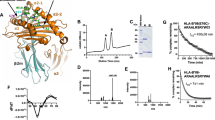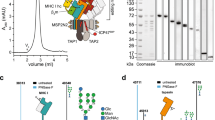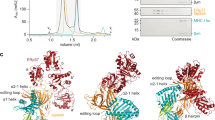Abstract
We define here the specificity and significance of proteases in the endoplasmic reticulum (ER) that generate peptides for presentation by major histocompatibility complex (MHC) class I molecules. We show that aminopeptidases efficiently trimmed all residues except proline that flank the NH2-termini of antigenic precursors in the ER and caused an accumulation of X-P-Xn peptides. An aminopeptidase inhibitor blocked peptide trimming in the ER and, consequently, the generation of peptide-loaded MHC molecules. Peptide trimming in the ER is therefore a key step in the MHC class I antigen-processing pathway and also explains the paradox of why many MHC class I molecules display peptides with the X-P-Xn motif despite the inability of the transporter associated with antigen processing to transport such peptides from the cytoplasm.
This is a preview of subscription content, access via your institution
Access options
Subscribe to this journal
Receive 12 print issues and online access
$209.00 per year
only $17.42 per issue
Buy this article
- Purchase on Springer Link
- Instant access to full article PDF
Prices may be subject to local taxes which are calculated during checkout








Similar content being viewed by others
References
Falk, K., Rotzschke, O., Stevanovic, S., Jung, G. & Rammensee, H.-G. Allele-specific motifs revealed by sequencing of self-peptides eluted from MHC molecules. Nature 351, 290–296 (1991).
Madden, D. R., Gorga, J. C., Strominger, J. L. & Wiley, D. C. The structure of HLA-B27 reveals nonamer self-peptides bound in an extended conformation. Nature 353, 321–325 (1991).
Pamer, E. G. & Cresswell, P. Mechanisms of MHC class I-restricted antigen processing. Annu. Rev. Immunol. 15, 323–358 (1998).
Paz, P., Brouwenstijn, N., Perry, R. & Shastri, N. Discrete proteolytic intermediates in the MHC class I antigen processing pathway and MHC I-dependent peptide trimming in the ER. Immunity 11, 241–251 (1999).
Schubert, U. et al. Rapid degradation of a large fraction of newly synthesized proteins by proteasomes. Nature 404, 770–774 (2000).
Reits, E. A. J., Vos, J. C., Gromme, M. & Neefjes, J. The major substrates for TAP in vivo are derived from newly synthesized proteins. Nature 404, 774–778 (2000).
Rock, K. L. et al. Inhibitors of the proteasome block the degradation of most cell proteins and the generation of peptides presented on MHC class I molecules. Cell 78, 761–771 (1994).
Rock, K. L. & Goldberg, A. L. Degradation of cell proteins and the generation of MHC class I-presented peptides. Annu. Rev. Immunol. 17, 739–779 (1999).
Attaya, M. et al. Ham-2 corrects the class I antigen-processing defect in RMA-S cells. Nature 355, 647–649 (1992).
Shepherd, J. C. et al. TAP1-dependent peptide translocation in vitro is ATP dependent and peptide selective. Cell 74, 577–584 (1993).
Androlowicz, M. J. & Cresswell, P. How selective is the transporter associated with antigen processing? Immunity 5, 1–5 (1996).
Yellen-Shaw, A., Lughlin, C. E., Metrione, R. M. & Eisenlohr, L. C. Murine transporter associated with antigen presentation (TAP) preferences influence class I-restricted T cell responses. J. Exp. Med. 186, 1655–1662 (1997).
Lauvau, G. et al. Human transporters associated with antigen processing (TAPs) select epitope precursor peptides for processing in the endoplasmic reticulum and presentation to T cells. J. Exp. Med. 190, 1227–1240 (1999).
Snyder, H. L., Yewdell, J. W. & Bennink, J. R. Trimming of antigenic peptides in an early secretory compartment. J. Exp. Med. 180, 2389–2394 (1994).
Elliott, T., Willis, A., Cerudolo, V. & Townsend, A. Processing of major histocompatibility class I-restricted antigens in the endoplasmic reticulum. J. Exp. Med. 181, 1481–1491 (1995).
Powis, S. J. et al. The Rat cim effect: TAP allele-dependent changes in a class I MHC anchor motif and evidence against C-terminal trimming of peptides in the ER. Immunity 4, 159–165 (1996).
Snyder, H. L. et al. Two novel routes of transporter associated with antigen processing (TAP)-independent major histocompatibility complex class I antigen processing. J. Exp. Med. 186, 1087–1098 (1997).
Shastri, N., Serwold, T. & Gonzalez, F. Presentation of endogenous peptide-MHC class I complexes is profoundly influenced by specific C-terminal flanking residues. J. Immunol. 155, 4339–4346 (1995).
Craiu, A., Akopian, T., Goldberg, A. & Rock, K. L. Two distinct proteolytic processes in the generation of a major histocompatibility complex class I-presented peptide. Proc. Natl Acad. Sci. USA 94, 10850–10855 (1997).
Serwold, T. & Shastri, N. Specific proteolytic cleavages limit the diversity of the pool of peptides available to MHC class I molecules in living cells. J. Immunol. 162, 4712–4719 (1999).
Anderson, K. et al. Endogenously synthesized peptide with an endoplasmic reticulum signal sequence sensitizes antigen processing mutant cells to class I-restricted cell-mediated lysis. J. Exp. Med. 174, 489–492 (1991).
Nielsen, H., Engelbrecht, J., Brunak, S. & von Heijne, G. Identification of prokaryotic and eukaryotic signal peptides and prediction of their cleavage sites. Protein Eng. 10, 1–6 (1997).
Hill, A. et al. Herpes simplex virus turns off the TAP to evade host immunity. Nature 375, 411–415 (1995).
Yellen-Shaw, A. J., Wherry, E. J., Dubois, G. C. & Eisenlohr, L. C. Point mutation flanking a CTL epitope ablates in vitro and in vivo recognition of a full-length viral protein. J. Immunol. 158, 3227–3234 (1997).
Malarkannan, S., Serwold, T., Nguyen, V., Sherman, L. A. & Shastri, N. The mouse mammary tumor virus env gene is the source of a CD8+ T-cell-stimulating peptide presented by a major histocompatibility complex class I molecule in a murine thymoma. Proc. Natl Acad. Sci. USA 93, 13991–13996 (1996).
Mentlein, R. Proline residues in the maturation and degradation of peptide hormones and neuropeptides. FEBS Lett. 234, 251–256 (1988).
Yaron, A. & Naider, F. Proline-dependent structural and biological properties of peptides and proteins. Crit. Rev. Biochem. Mol. Biol. 28, 31–81 (1993).
Vanhoof, G., Goossens, F., De Meester, I., Hendriks, D. & Scharpe, S. Proline motifs in peptides and their biological processing. FASEB J. 9, 736–744 (1995).
Malarkannan, S., Goth, S., Buchholz, D. R. & Shastri, N. The role of MHC class I molecules in the generation of endogenous peptide/MHC complexes. J. Immunol. 154, 585–598 (1995).
Rammensee, H. G., Friede, T. & Stevanovic, S. MHC ligands and peptide motifs: First listing. Immunogenetics 41, 178–228 (1995).
Barber, L. D. et al. Overlap in the repertoires of peptides bound in vivo by a group of related class I HLA-B allotypes. Curr. Biol. 5, 179–190 (1995).
Van Endert, P. M. et al. The peptide-binding motif for the human transporter associated with antigen processing. J. Exp. Med. 182, 1883–1895 (1995).
Neisig, A. et al. Major differences in transporter associated with antigen presentation (TAP)-dependent translocation of MHC class I-presentable peptides and the effect of flanking sequences. J. Immunol. 154, 1273–1279 (1995).
Storkus, W. J., Zeh, H. J. III, Salter, R. D. & Lotze, M. T. Identification of T-cell epitopes: rapid isolation of class I-presented peptides from viable cells by mild acid elution. J. Immunother. 14, 94–103 (1993).
Anton, L. C., Yewdell, J. W. & Bennink, J. R. MHC class I-associated peptides produced from endogenous gene products with vastly different efficiencies. J. Immunol. 158, 2535–2542 (1997).
Dick, L. R. et al. Proteolytic processing of ovalbumin and β-galactosidase by the proteasome to yield antigenic peptides. J. Immunol. 152, 3884–3894 (1994).
Dick, T. P. et al. Coordinated dual cleavages induced by the proteasome regulator PA28 lead to dominant MHC ligands. Cell 86, 253–262 (1996).
Niedermann, G. et al. Contribution of proteasome-mediated proteolysis to the hierarchy of epitopes presented by major histocompatibility complex class I molecules. Immunity 2, 289–299 (1995).
Falk, K., Rötzschke, O. & Rammensee, H.-G. Cellular peptide composition governed by major histocompatibility complex class I molecules. Nature 348, 248–251 (1990).
Zuberi, A., Christianson, G. J., Mendoza, L. M., Shastri, N. & Roopenian, D. C. Positional cloning and molecular characterization of an immunodominant cytotoxic determinant of the mouse H3 minor histocompatibility complex. Immunity 9, 687–698 (1998).
Falk, K., Rotzschke, O., Stevanovic, S., Jung, G. & Rammensee, H. G. Pool sequencing of natural HLA-DR, DQ, and DP ligands reveals detailed peptide motifs, constraints of processing, and general rules. Immunogenetics 39, 230–242 (1994).
Nelson, C. A., Vidavsky, I., Viner, N. J., Gross, M. L. & Unanue, E. R. Amino-terminal trimming of peptides for presentation on major histocompatibility complex class II molecules. Proc. Natl Acad. Sci. USA 94, 628–633 (1997).
Karttunen, J., Sanderson, S. & Shastri, N. Detection of rare antigen presenting cells by the lacZ T-cell activation assay suggests an expression cloning strategy for T-cell antigens. Proc. Natl Acad. Sci. USA 89, 6020–6024 (1992).
Malarkannan, S., Afkarian, M. & Shastri, N. A rare cryptic translation product is presented by Kb major histocompatibility complex class I molecule to alloreactive T cells. J. Exp. Med. 182, 1739–1750 (1995).
Mendoza, L., Villaflor, G., Eden, P., Roopenian, D. C. & Shastri, N. Distinguishing self from nonself. Immunogenicity of the murine H47 locus is determined by a single amino acid substitution in an unusual peptide. J. Immunol. 166, 4438–4445 (2001).
Mendoza, L. et al. Minors held by majors. The H13 minor histocompatibility locus defined as a peptide/MHC class I complex. Immunity 7, 461–472 (1997).
Shastri, N., Nguyen, V. & Gonzalez, F. Major histocompatibility class I molecules can present cryptic translation products to T-cells. J. Biol. Chem. 270, 1088–1091 (1995).
Sanderson, S. & Shastri, N. LacZ inducible peptide/MHC specific T-hybrids. Int. Immunol. 6, 369–376 (1994).
Shastri, N. & Gonzalez, F. Endogenous generation and presentation of the OVA peptide/Kb complex to T-cells. J. Immunol. 150, 2724–2736 (1993).
Walter, P. & Blobel, G. Preparation of microsomal membranes for cotranslational protein translocation. Meth. Enzymol. 96, 84–93 (1983).
Acknowledgements
We thank L. Mendoza and other investigators who provided us with key reagents and S. Schwab for comments on the manuscript. Supported by grants from the NIH (to N. S.).
Author information
Authors and Affiliations
Corresponding author
Rights and permissions
About this article
Cite this article
Serwold, T., Gaw, S. & Shastri, N. ER aminopeptidases generate a unique pool of peptides for MHC class I molecules. Nat Immunol 2, 644–651 (2001). https://doi.org/10.1038/89800
Received:
Accepted:
Issue Date:
DOI: https://doi.org/10.1038/89800
This article is cited by
-
ERAP1 promotes Hedgehog-dependent tumorigenesis by controlling USP47-mediated degradation of βTrCP
Nature Communications (2019)
-
Antigen Cross-Presentation and Heat Shock Protein-Based Vaccines
Archivum Immunologiae et Therapiae Experimentalis (2016)
-
The common equine class I molecule Eqca-1*00101 (ELA-A3.1) is characterized by narrow peptide binding and T cell epitope repertoires
Immunogenetics (2015)
-
Immunogenicity of necrotic cell death
Cellular and Molecular Life Sciences (2015)
-
ERAP1 in the pathogenesis of ankylosing spondylitis
Immunologic Research (2014)



